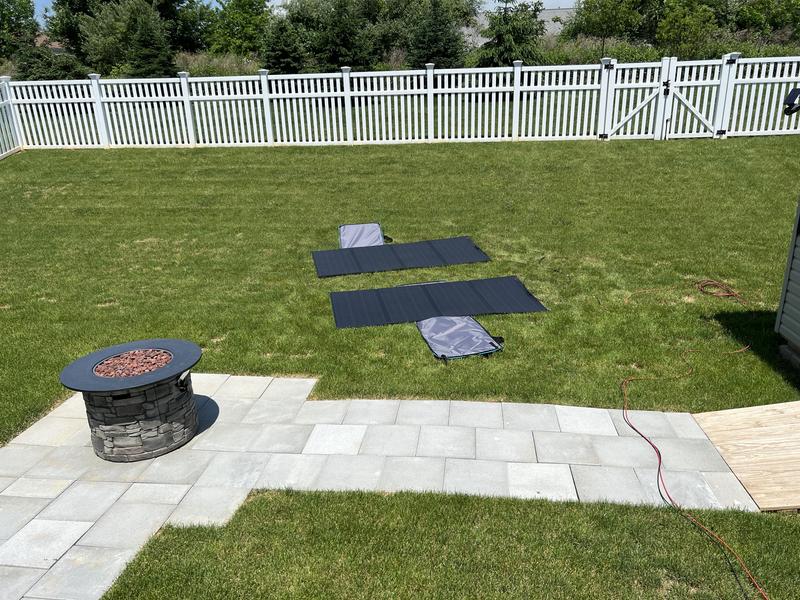How Portable Solar Panels Can Cut Energy Costs and Boost Profits for Vending Machines
- How a Solar-Powered Vending Machine Works
- 5 Key Benefits of Using Portable Solar Panels for Vending Machine
- A Closer Look at How a Portable Solar Panel Cuts Vending Machine Operation Costs
- How to Choose the Right System with Portable Solar Panel Options
- Step into the Future of Vending with Solar Power
- FAQs About Operating Vending Machines with Solar Power
Suppose you place a vending machine full of cold drinks on a busy hiking trail or a sunny beach. It’s miles from the nearest power outlet, but it’s making great money. Now, picture your biggest monthly bill—for electricity—completely gone.
This is totally feasible for business owners to grow. Traditional vending machines have two big problems. They need to be plugged into a wall, and they use power 24/7, which costs a lot of money. Read this blog, you'll learn how a portable solar panel setup fixes both issues.
How a Solar-Powered Vending Machine Works
A solar power system for a vending machine is a simple and reliable setup. It works by catching, storing, and giving out power when the machine needs it. You can think of it like a big power bank for your machine. The sun charges it up for free all day. Then the machine uses that power to run day and night, so you never stop making sales.
The Solar Panel Itself
The solar panel does the main job. It sits in the sun and turns the light into DC electricity. Good solar panels are strong and work well, acting like a big solar panel portable charger for the battery. They are usually put on top of the machine to get the most sun.
For a rugged, grab‑and‑go array, a pair of foldable EcoFlow 400W Portable Solar Panels with IP68 weatherproofing and a kickstand case makes daily harvest easy on beaches and trails.
The Charge Controller
The charge controller is the brain of the system. It’s a small part that goes between the panel and the battery. Its job is to control the power flow. This keeps the battery from getting too much charge, which helps it last longer.
The Battery Bank
The battery is where the power is stored. It holds the electricity from the solar panel. This way, the machine still has power at night or on cloudy days. A bigger battery means the machine can run longer without sun, keeping your business going.
EcoFlow DELTA 2 Max starts at 2048Wh and expands to ~6kWh with long‑life LFP cells (≈3000 cycles to 80%), ideal for snack machines or efficient fridges needing night/cloudy‑day autonomy.
The Power Inverter
Vending machines use AC power, the kind from a wall outlet. But the battery stores DC power. The inverter is a translator. It changes the DC power from the battery into the AC power the machine needs to work.
A solar power setup is a complete system that makes its own clean energy. These four parts work together to create a power source that can run your machine anywhere.
5 Key Benefits of Using Portable Solar Panels for Vending Machine
Portable solar panel systems bring more than just green appeal.
- Lower electricity bills: Sunlight is free. Using solar during daylight hours can reduce drawing from the power grid, which cuts monthly energy expenses.
- Higher net profits: Reduced operating costs mean a larger share of income remains as profit. Payback on the solar investment can happen in a few years if well matched.
- Better flexibility of placement: Machines can be located where power outlets are scarce or costly to install. Solar setups allow placement in parks, events, or roadside locations without grid access. Putting your machine in these smart, busy spots means more sales. The table below shows some examples of these profitable new markets.
Location Type | Why It's a Great Opportunity | The Solar Advantage |
Parks & Fun Areas | Serves high-traffic areas where people are active and looking for drinks or snacks. | No need to rely on park buildings for power; can be placed directly on trails or near playgrounds. |
Beaches & Tourist Spots | Caters to a "captive audience" of visitors who stay for hours and will pay for convenience. | Operates without any existing infrastructure, buildings, or power lines. |
Outdoor Events & Festivals | Gives you access to large, concentrated crowds at concerts, markets, and fairs. | The setup is mobile and easy to move, allowing you to follow profitable events all year. |
Construction Sites | Provides a valuable and convenient service to a consistent, daily customer base. | Can be placed at temporary job sites that often lack convenient and accessible power outlets. |
Enhanced reliability: Battery storage ensures that machines stay powered even when the power grid fails or during cloudy/rainy periods.
Positive brand impression: Customers like seeing eco-friendly operations. Using solar for companies shows environmental responsibility, which can attract more users.
All in all, choosing a solar panel portable charger system or full panel + battery solution gives financial savings, more placement options, reliability, and good customer perception.


A Closer Look at How a Portable Solar Panel Cuts Vending Machine Operation Costs
Solar power also helps you save money. It gets rid of one of the biggest costs for any vending operator: the power bill. A machine with a fridge uses a lot of energy. It runs 24 hours a day, all year long. These costs add up and take a big bite out of your profits.
The table below shows a simple cost comparison for one refrigerated vending machine over five years. It assumes an average energy use of 5 kWh a day with an efficient refrigerated machine and a power rate of $0.17 per kWh, which is a common rate in the U.S. The solar setup assumes a one-time investment cost without ongoing fuel expenses.
Cost Analysis Over 5 Years | Grid-Powered Vending Machine | Solar-Powered Vending Machine |
Daily Electricity Cost | ~$0.85 | $0.00 |
Annual Electricity Cost | ~$310 | $0.00 |
Total Electricity Cost (5 Years) | ~$1,550 | $0.00 |
Initial System Cost | $0.00 | ~$1,800 - $3,000 (Varies) |
Total 5-Year Cost | ~$1,550 | ~$1,800 - $3,000 |
Payback Period | N/A | Typically 5-8 Years |
Even though there is an upfront investment for equipment, the savings over the long term add up quickly. Once the system is paid off through energy savings, the energy it creates is essentially free, and more of the revenue from every sale finds its way into your pocket directly. Investing in solar for companies, even on a small scale like this, is a great method for long-term financial health.
How to Choose the Right System with Portable Solar Panel Options
Younger entrepreneurs and vending-machine operators need solid guidance. This section helps to pick the right one.
Estimate Power Needs
Measure actual daily energy consumption by the machine (use a watt meter over 24 hours or more), including refrigeration, lighting, and extra load. Take seasonal variation (hot vs cold weather makes refrigeration draw more power) into account.
Choose Solar Panel Capacity
Pick panels that produce enough watts during peak sun hours so battery charges fully. Portable solar panel options come with different watt ratings (e.g. 100 W, 200 W, up to hundreds of watts).
Select Battery Storage
Lithium or deep-cycle batteries are preferred for their longer lifespan. Aim for enough storage to cover nights and a few cloudy days (so the vending machine doesn’t lose service).
Consider Portable Power Station with Solar Panel
A complete portable power station with solar panel kit combines battery, inverter, and solar input in one package. They simplify setup and make mobile or temporary vending setups easier.
Check Local Climate & Sun Exposure
The location of the vending machine should get good sunlight and avoid shade. Panel angles matter. Tilt and orientation affect how much solar energy you get.
Account for Maintenance and Lifespan
Panels need cleaning. Dust, debris, snow reduce output.
Batteries degrade over time; check warranties.
Power needs matching, panel and battery selection based on machine's load, system selection including portable power station with solar panel, and planning for maintenance are key for success.
Step into the Future of Vending with Solar Power
By using solar power, you can build a business that is more flexible, strong, and profitable. You get the freedom to put your vending machines in the best spots. Now, you've seen how solar can free your business from the grid and unlock new opportunities. Let's take the first step. The EcoFlow DELTA 2 Max provides the reliable, long-lasting battery life you need, while the 400W Portable Solar Panels give you the flexibility to harvest energy anywhere. This is the perfect toolkit for building a smarter, more profitable business for the years ahead.


FAQs About Operating Vending Machines with Solar Power
Q1: What is the difference in system performance between summer and winter?
A: The amount of energy output for a solar system changes with the seasons. In the summer, the days are longer and the sun is higher in the sky. That allows the panels to make a lot more energy. In the winter, the days are shorter and the sun is lower. That means there are fewer days' worth of energy being produced. A good system is planned for this. It will typically have a larger battery bank to store energy for a few short winter days. Raising the panels more steeply in winter also increases their capacity to catch more light.
Q2: Are there some vending machines better for solar power?
A: Yes, there are some machines that perform better with solar. The best ones are newer, energy-saving models with LED lights and good insulation. Non-fridge machines like those for snacks need very little power. They are very easy to run on a small solar system. You can run a modern refrigerated machine on solar. But you need a very large and expensive panel and battery system. That is because it uses a lot of energy all the time. Older machines that are inefficient are not very desirable.
Q3: What about security for a solar installation in a public place?
A: It is very important to secure any equipment left outdoors. Solar panels should be fitted with special tamper-proof bolts. This makes it difficult for them to be stolen. The battery and other components should be stored in a strong, locked metal box. This can be fastened onto the machine or left beside the machine. An all-in-one power station can also make securing items easier since you only need one box to secure. Placing machines in crowded, well-lit locations also prevents them from being stolen.
Q4: Are there incentives or rebates available for using solar for companies?
A: Yes. At federal and state government levels within the United States, there are tax credits, rebates, and incentives for solar power systems, and they often include battery storage. As an example, the Investment Tax Credit (ITC) generally offers a percentage of installation cost back as a credit. There can also be rebates or net-metering offered by utility or municipal programs. The percent and eligibility depend on location, system size, and if the installation qualifies for standards.